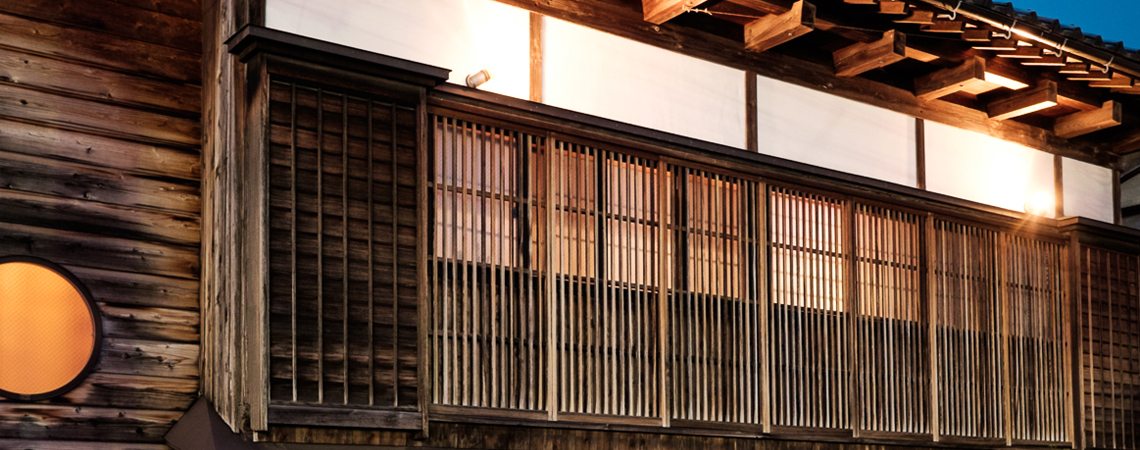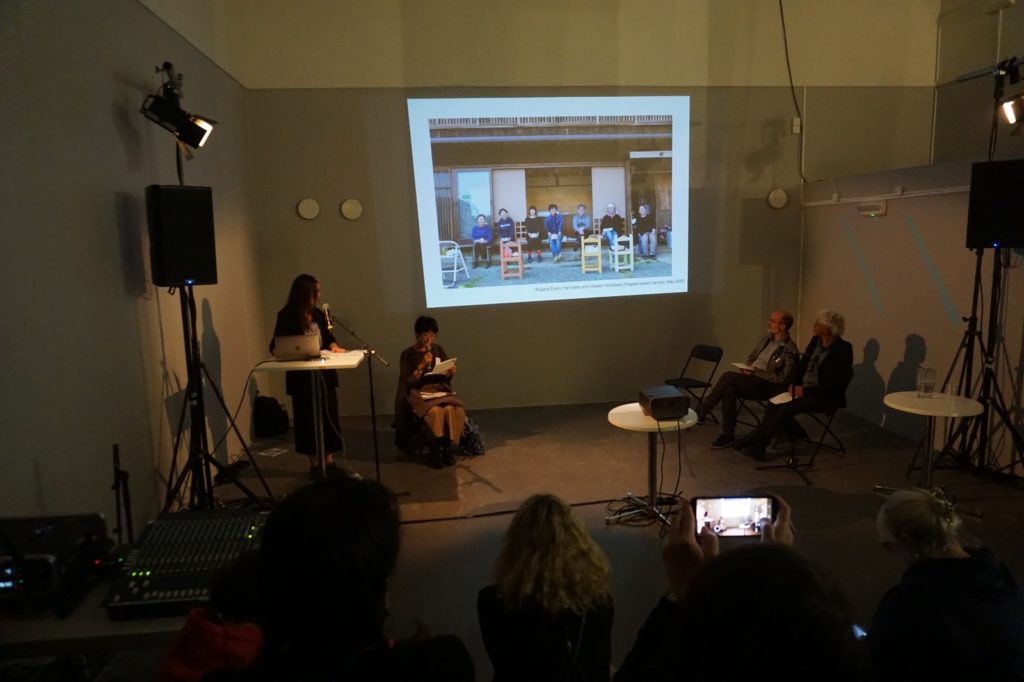Niigata Eya Gallery
Niigata Eya is an art gallery independently operated by a group of individuals working in different genres, and was certified as a “non-profit organization (NPO)” in 2005. The Gallery is a place for artists to present their work and for viewers to encounter their expressions. The gallery’s management is dependent on the sale of art works, but in order to maintain diversity, it also relies on membership fee income as another foundation, allowing for greater flexibility in the planning of exhibitions.
What is Exhibition?
The main activities of Niigata Eya are exhibitions held in the gallery room of a renovated Taisho period(1912−1926)traditional Japanese style house. The art show is a place to introduce artworks and artists that the individual “viewer” considers “good” to a wide audience, and the exhibition planner is responsible for all aspects of the event. The offering conceived from the appreciation and evaluation of an individual, is a stage that creates a place for presentation and appreciation of artwork at a distance from the influence of “information” bias originating in the metropolitan area. The art expressions are proposed and discussed at the monthly committee meetings, and Niigata Eya provides full support for the realization of the exhibitions.
From the gallery to the outside community
We are conducting “eto” (“with paintings” in Japanese), a project to promote the creation of spaces with pictures, in the hope that daily life will become more lively by gracing your home or work space with pictures. We also publish a monthly exhibit guide, “Niigata Island and Surrounding Galleries & Museums Map,” to help visitors enjoy art work at galleries and museums.
▶︎Reference
SUPERMARKET – Stockholm Independent Art Fair 2022
Presentation about Niigata Eya Gallery by Azumi Okabe
“Art Shots,” which introduced each activity, was presented in a “pecha-kucha” style, in which 10 images were presented in less than one minute each. No questions were raised on this day, perhaps because the presentation ended with a brief overview of each activity. In particular, Niigata Eya is a gallery run by “viewers” rather than an artist-run gallery, and I explained that the historical background of the introduction of the term “art” was a translation of the word “Bijutsu.” However, I also thought that they might not have known what questions to ask because of the very different backgrounds. (Niigata Eya’s presentation is following)
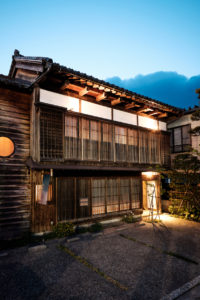
1 Niigata Eya Gallery’s building
Niigata Eya Gallery is not an artist-run gallery, it is a viewer-oriented gallery.
Niigata city is located in the northeastern part of Honshu Island, Japan, lying along with the Sea of Japan.As you see, the gallery’s building is a traditional Japanese style house, but the interior had been renovated in the western style. We restored the interior back to its original design. Our intent was to have a place to exhibit paintings and various other genres of art expressions, as well as, to offer them for sale, in this traditional Japanese style setting.
“Eya” means a shop that sells paintings in old Japanese language. Niigata Eya Gallery was established in 2000 by 9 members.
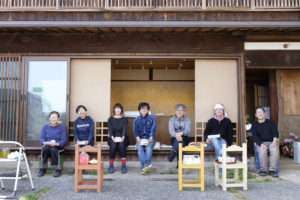
2 Niigata Eya’s members and Hisako Horikawa(Niigata-based dancer)
The members consist of a carpenter, a furniture craftsman, a Haiku poet, a graphic designer, a photographer, an art critic, and others in various fields; every single member takes charge of managing the activities, not as an artist, but as an individual viewer.
At monthly meetings, we introduce artists respectively, that we think are good, and curate exhibitions.
We have held more than 600 exhibitions with over 300 artists over 22 years.
The standard of curation is to present the art works that a Niigata Eya member appreciated and desired to feature as an individual viewer.
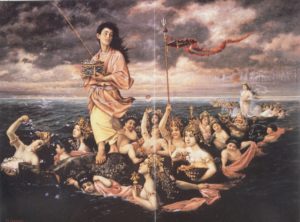
3 An Oil painting in the Meiji(1868-1912)Era_ “Urashima_zu” by Hosui Yamamoto(1895)
Art or plastic art in the Japanese language is “Bijutsu.” “Bi” means “beauty,” and “Jutsu” means “way”, ”method,” or “meaning.” Japan’s Meiji Era ran from 1868 to 1912, and “Bijutsu” was created by translation in its early years.
This new word, “Bijutsu,” produced the new social system, such as in art schools, museums and exhibitions.
This change occurred first in Tokyo, the capital city of Japan; thus, Tokyo is considered the source of everything new as it is the mega introduction place of Western culture.
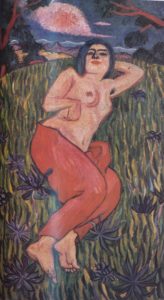
4 A Painting in the Taisyo (1912-26)Era_”Nude Beauty” by Tetsugoro Yorozu(1912)
Soon after the word “Bijutsu” was coined, the drastically changing era, the 20th century started, and revolutionary art works showed up one after another; they appeared in Tokyo rapidly. Especially Van Gogh was introduced to art-lover youths by a literature group named the “Sirakaba group;” this dramatically spread the concept that Bijutsu to not only mean the creation of beauty but also it is about self-expression.
This thought had a huge impact on art expression in Japanese people and it extended the range of “beauty;” but also it confused viewers who look for “beauty” in art pieces.
As a result, it was believed that “only art specialists could appreciate and understand the art.” This mind- set prevailed among ordinary people.
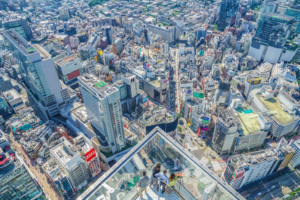
5 Tokyo scenery
Then, people aiming toward art expression went to Tokyo, created in Tokyo, and exhibited in Tokyo.
In the late Maiji era, the exhibitions started to be presented by the national government, which was mimicking the Salon in France.
Private competitions also began, and these became a hierarchical system.
Climbing up the pyramid of hierarchy became equivalent to gaining social prestige.
In this era, the people left behind the most were the viewers who appreciate the arts but lived in other areas than Tokyo.
They judged art expressions under the mind-set of following what others said. Appreciating art meant going to the museum to see so-called famous artists’ works. This practice became the norm.
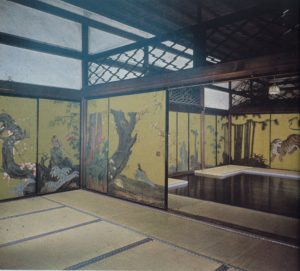
6 Interior of an old temple
Before the word, “Bijutsu”, paintings, sculptures and crafts existed close to Japanese people’s daily lives.
For instance, there might have been a rich person’s house, that had a place called “Tokonoma,” where art pieces were displayed and viewed.
Painted Fusuma and painted Shoji functioned as partitioning walls defining rooms and spaces within a building.
However, westernizing house styles removed Tokonoma, and got rid of paintings from doors. Paintings that were once intimately entwined with daily lives became special entities, cut-off from our lives, and were only being appreciated through the cognitive bias of the hierarchy system on unusual occasions at an exhibition venue.
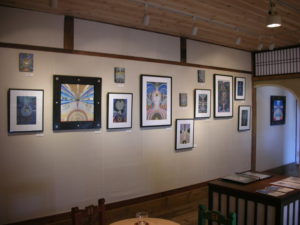
7 Exhibition scenery in Niigata Eya _ Antje E. Gummels’s exhibition
Despite Japanese people starting to live in the western style rooms having many walls, Japanese didn’t hang any paintings on those walls.
Niigata Eya Gallery was born in Niigata city, which is one of the cities in this situation.
We turned Niigata Eya’s space that had been renovated in the western style back to the original interior.
This way of creating the space had meaning.
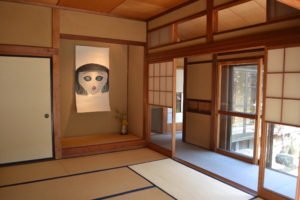
8 “Chieko”by Sinzow hung on Tokonoma in Sakyukan,another exhibition space curated by Niigata Eya
During the last 20 years the trending idea was that artists, including those who recognized themselves as contemporary artists, must move to Tokyo has changed; instead, they held exhibitions in other regions of Japan to increasing extents.
We believe art expression is an action that is created in the inner-depth of an individual’s mind, that is deeper than one’s need for approval; and its meaning is appreciated most clearly only when people view them with their own eyes as an individual.
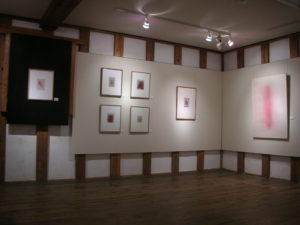
9 Hiroshi Kurita’s exhibition in Sakyukan
Through 22 years of activities, Niigata Eya has met many of those artists.
No need to say, there were lots of Niigata-based artists among them. Last autumn, due to the entry ban, we couldn’t bring those artists’ works here; but thanks to Masoud, Studio44’s amazing support, although these were copies, we were able to exhibit the Niigata-based artists’; Hiroshi Kurita, Sinzow and Momo Hasuike’s paintings at Niigata Eya’s booth in the SUPERMARKET ART FAIR 2021.
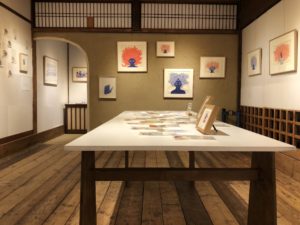
10 Momo Hasuike’s exhibition in Niigata Eya
The goal of Niigata Eya Gallery was to transform an exhibition space which had been previously monopolized by the artists group in the hierarchy system into the place where artist meets viewer individually. This was an adventure to meet the “creator” through thoroughly ensuring the individuality of “appreciation.” In Japan’s history, a gallery was born and grew up as a part of hierarchy. Niigata Eya was a movement to redefine the meaning of a gallery, focusing on the individual’s point of view.
We also publish a gallery map monthly to deliver information about exhibitions held in various galleries in Niigata city. In Japan, actually our information tool is still very much paper-oriented, not digital.
Apart from selling paintings to the local homeowners, to recreate intimate relationships between contemporary art expression and daily lives, we run a program named “eto,” which means “with paintings” in Japanese. We bring paintings to offices and hospitals for display and replace them regularly.Unfortunately, we haven’t established a concrete system that produced proper profit for the artists and us, but this activity is one of the ways to realize Niigata Eya’s purpose.
We gratitude to IASPIS and Scandinavian Japan Sasakawa Foundation for giving us the opportunity to meet many good people in Stockholm.
English translation was polished by Ron Takata
▶ SUPERMARKET 2024
▶ SUPERMARKET 2022 Report(日本語版)/(English edition)
▶ SUPERMARKET 2021(Japanese)
▶ SUPERMARKET 2020(Japanese)

